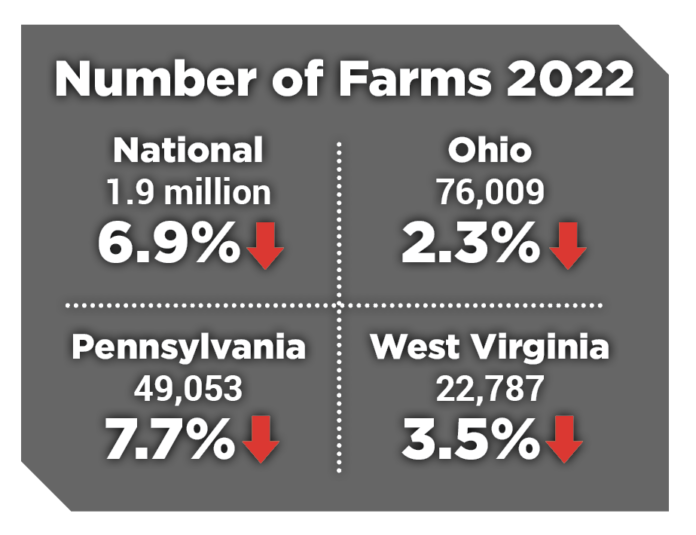SALEM, Ohio — The U.S. has the smallest number of farms since 1850, losing 141,733 farms from 2017 to 2022, according to the 2022 U.S. Department of Agriculture Census of Agriculture.
There are now only 1.9 million farms in the U.S., down 7% from 2017. This is the largest percent decrease that’s been seen in 20 years.
The latest Census of Agriculture, results of which were released last week, also showed that farm consolidation continues unabated, with the number of the largest farms increasing and fewer farms accounting for the majority of ag products sold.
“I’m concerned about the state of agriculture and food production in this country,” said Agriculture Secretary Tom Vilsack, during a data release event on Feb. 13. Vilsack called the results a wake-up call for the industry, policymakers and politicians.
The numbers
Ohio, Pennsylvania and West Virginia each lost farms since the last census, Ohio with a 2.3% loss, Pennsylvania with a 7.7% loss and West Virginia at 3.5%.
Even given the loss of farms, Ohio still has the fourth most farms in the country with 76,009, ranking below Iowa, Missouri and Texas.
There was a 2% drop in farmland nationwide, down to 880.1 million acres in 2022, according to the census. That’s a loss of just over 20 million acres in five years.
“I want to give you a sense of how many acres that is. That’s every New England state with the exception of Connecticut, in five years,” Vilsack said.
The tri-state area also lost farmland, with Ohio losing about 313,000 acres, Pennsylvania losing 220,000 acres and West Virginia losing 113,000 acres since 2017.
A bright spot in the 2022 census results was an increase in the number of young and beginning producers. The number of producers under age 35 increased by nearly 4% in 2022 from five years ago, jumping from 285,434 in 2017 to 296,480 in 2022. Young producers made up about 9% of all producers in 2022.
There were just over 1 million beginning farmers with 10 or fewer years of experience in 2022 an increase of 11% from 2017.
Consolidation
U.S. farms and ranches produced $543 billion in agricultural products, up from $389 billion in 2017. Even with production expenses growing by 30%, U.S. farms overall had a net cash income of $152 billion in 2022.
However, less than half of farms, 43%, had positive net cash farm income in 2022.
The number of large-scale farms with more than $1 million in sales increased by 40% in 2022. These farms sold more than three-quarters of all agricultural products, made up 6% of all farms and operated 31% of the farmland in the country.
Farms with less than $100,000 in sales, which make up about 80% of American farms, dropped by 9%.
The Census of Agriculture, first held in 1840, is conducted every five years to gather thousands of data points about domestic agricultural operations.
A farm is defined, by the census, as any place from which $1,000 or more agricultural products were produced and sold. In 1850, when there were only 31 states and four territories, there were 1.4 million farms. The number of farms in the U.S. peaked in 1935, with 6.8 million farms.
The Ag Census results renewed calls from farm groups for Congress to pass a new farm bill. American Farm Bureau Federation President Zippy Duvall said the latest census numbers “put in black and white the warning our members have been expressing for years.”
“Increased regulations, rising supply costs, lack of available labor and weather disasters have all squeezed farmers to the point that many of them find it impossible to remain economically sustainable,” he said, in a statement.
More numbers
The average size of a U.S. farm in 2022 was 463 acres, up from 441 acres in 2017.
The average age of American farmers crept up to 58.1 in 2022. The average age has been increasing over the years — 57.5 in 2017 and 56.3 in 2012 — but the USDA noted this was a smaller increase than between previous censuses.
The number of male and female producers is about the same, with about 2.1 million men and 1.2 million women, or 64% to 36%.
(Editor Rachel Wagoner can be reached at 724-201-1544 or rachel@farmanddairy.com.)











